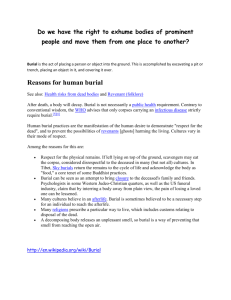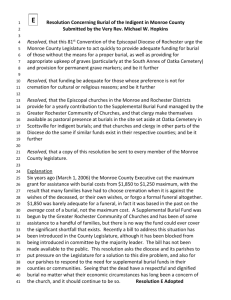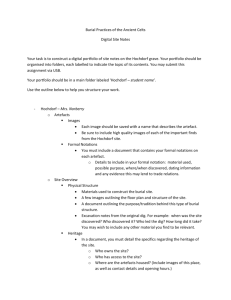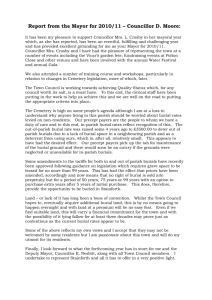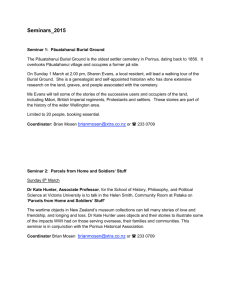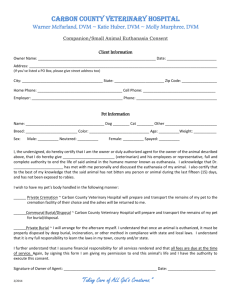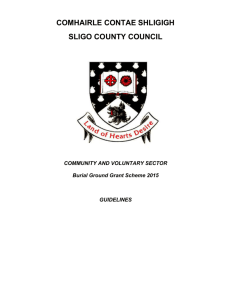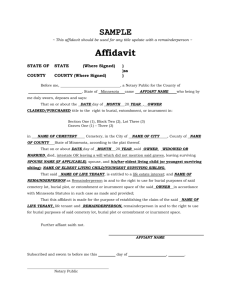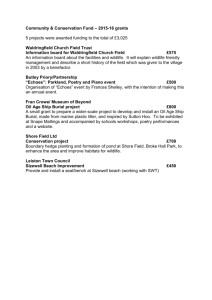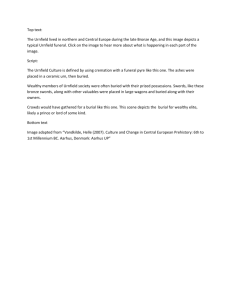AAP6086 Autumn Semester 2012-13 Death and Burial in Anglo
advertisement
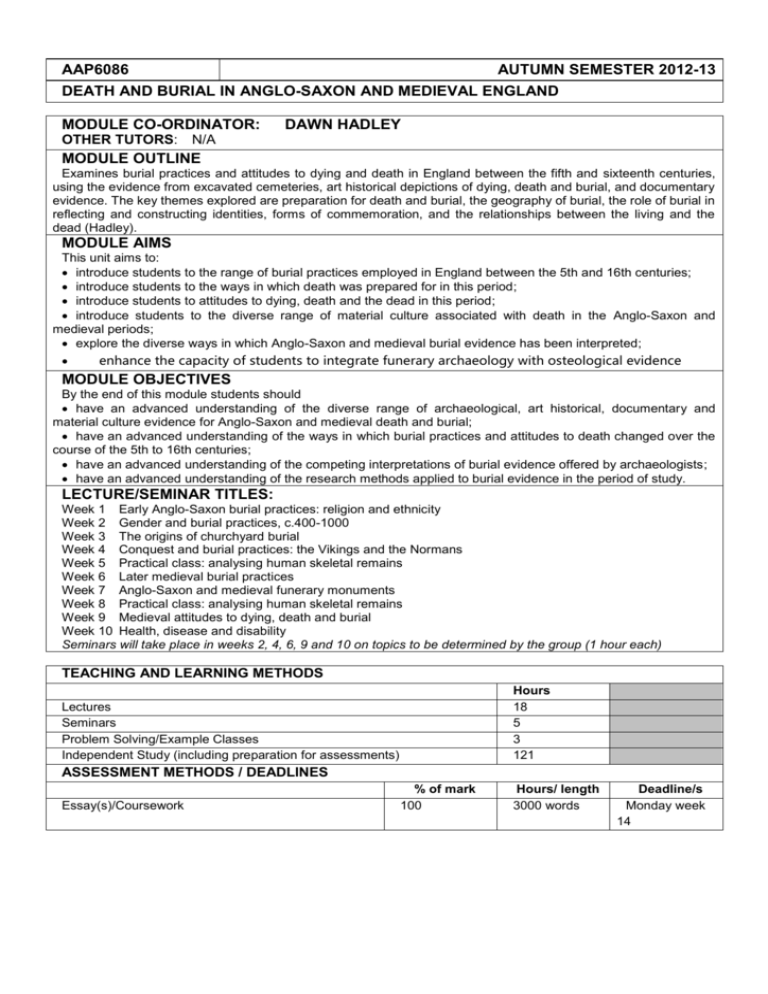
AAP6086 AUTUMN SEMESTER 2012-13 DEATH AND BURIAL IN ANGLO-SAXON AND MEDIEVAL ENGLAND MODULE CO-ORDINATOR: OTHER TUTORS: DAWN HADLEY N/A MODULE OUTLINE Examines burial practices and attitudes to dying and death in England between the fifth and sixteenth centuries, using the evidence from excavated cemeteries, art historical depictions of dying, death and burial, and documentary evidence. The key themes explored are preparation for death and burial, the geography of burial, the role of burial in reflecting and constructing identities, forms of commemoration, and the relationships between the living and the dead (Hadley). MODULE AIMS This unit aims to: introduce students to the range of burial practices employed in England between the 5th and 16th centuries; introduce students to the ways in which death was prepared for in this period; introduce students to attitudes to dying, death and the dead in this period; introduce students to the diverse range of material culture associated with death in the Anglo-Saxon and medieval periods; explore the diverse ways in which Anglo-Saxon and medieval burial evidence has been interpreted; enhance the capacity of students to integrate funerary archaeology with osteological evidence MODULE OBJECTIVES By the end of this module students should have an advanced understanding of the diverse range of archaeological, art historical, documentary and material culture evidence for Anglo-Saxon and medieval death and burial; have an advanced understanding of the ways in which burial practices and attitudes to death changed over the course of the 5th to 16th centuries; have an advanced understanding of the competing interpretations of burial evidence offered by archaeologists; have an advanced understanding of the research methods applied to burial evidence in the period of study. LECTURE/SEMINAR TITLES: Week 1 Early Anglo-Saxon burial practices: religion and ethnicity Week 2 Gender and burial practices, c.400-1000 Week 3 The origins of churchyard burial Week 4 Conquest and burial practices: the Vikings and the Normans Week 5 Practical class: analysing human skeletal remains Week 6 Later medieval burial practices Week 7 Anglo-Saxon and medieval funerary monuments Week 8 Practical class: analysing human skeletal remains Week 9 Medieval attitudes to dying, death and burial Week 10 Health, disease and disability Seminars will take place in weeks 2, 4, 6, 9 and 10 on topics to be determined by the group (1 hour each) TEACHING AND LEARNING METHODS Hours 18 5 3 121 Lectures Seminars Problem Solving/Example Classes Independent Study (including preparation for assessments) ASSESSMENT METHODS / DEADLINES Essay(s)/Coursework % of mark 100 Hours/ length 3000 words Deadline/s Monday week 14 AAP6108 AUTUMN SEMESTER 2012-13 TITLE: PEOPLES, POWER AND BELIEF IN DARK AGE BRITAIN MODULE CO-ORDINATOR: JOHN MORELAND MODULE OUTLINE In this module you will be introduced to the main developments in the archaeology and history of the British Isles between AD400-800, i.e. between the end the Roman empire and the beginning of the Viking incursions. This will serve as the backdrop for a detailed consideration of some of the key themes of the era – the Fall of the Roman Britain, the appearance of the new ‘peoples’ who dominate the historical accounts, the development of new forms of social power, the process of Christianisation, and (of course) the relationship between material culture and texts. MODULE AIMS This unit aims to: provide an understanding of the historical process between the end of the Roman empire and AD800 provide a opportunity to consider in depth some of the key issues of the period provide a detailed analysis of the social processes that underpinned the Age of Migrations provide a detailed consideration of bases on which power was constructed amongst the peoples of British Isles explore the significance of belief in the lived-experience of early medieval peoples illustrate the significance of production (agrarian and craft) in both social power and the historical process. assess the continued significance of ‘Rome’ throughout the period and region. MODULE OBJECTIVES By the end of this unit students should have a good understanding of historical developments in the period/region a detailed understanding of key issues that underpinned the historical process a good understanding of the archaeological and textual sources available for studying the period a critical understanding of their value both as elements in the social process in the past, and as sources of evidence for that past a sophisticated understanding of the ways in which identities are constructed a sophisticated understanding of the relationship between identities and material culture a sophisticated understanding of the relationship between belief and material culture an awareness of the reality of diversity and difference across the period/region an awareness of the commonalities that characterise the period/region. LECTURE/SEMINAR TITLES: 1 2 3 4 5 6 7 8 9 10 11 JM JM JM JM JM JM JM JM JM JM JM Lecture - Britain in late Antiquity Seminar – Roman Britain: Catastrophic collapse? Seminar – Ethnogenesis in late Antiquity? Seminar – Germanic genes? Lecture - Constructing the Anglo-Saxons Lecture – Northumbria: an archaeology of power No class Lecture – Power and belief in Early Christian Ireland Seminar – Pictish symbol stones Seminar – Recovering belief from urns, graves and barrows Seminar – Reading belief from monumental crosses TEACHING AND LEARNING METHODS Hours 9 8 133 Seminars Lectures Independent Study (including preparation for assessments) ASSESSMENT METHODS / DEADLINES % of mark Essay(s)/Coursework 100 Hours/ length 3000 Deadline/s Monday Week 14 AAP6116 SPRING SEMESTER 2012-13 VIKING-AGE EUROPE MODULE CO-ORDINATOR: OTHER TUTORS: DAWN HADLEY N/A MODULE OUTLINE Explores the archaeology and history of Scandinavia and the areas of Scandinavian colonisation between AD700 and 1200. We begin by looking at the settlements, society, economy, belief systems and polities of the Scandinavian peoples, and move on to concentrate on those regions in which Scandinavians raided, traded and settled from the later eighth century - including England, Ireland, Scotland and the Isles, the Isle of Man, the North Atlantic and continental Europe (including Russia, France and the Low Countries). The key themes are ethnicity and cultural identity, the transformation of economic systems, the nature of belief systems, the impact of Christianity, the variability of gender identities and the construction of the past in the present. MODULE AIMS This unit aims to: introduce students to the wide array of evidence for Scandinavian society during the Viking Age introduce students to the impact of the Scandinavians on those parts of Europe and the North Atlantic that they raided and settled between c.800 and 1100 introduce students to the diversity of discipline-specific debates about the Age of the Vikings introduce students to the competing historiographical traditions in the various regions in which Scandinavians raided and settled MODULE OBJECTIVES By the end of this module students should have an advanced knowledge of the diverse sources of evidence for the Viking Age in Scandinavia have an advanced knowledge of the diverse sources of evidence for the Scandinavian impact on Europe and the North Atlantic have a capacity to integrate diverse sources of evidence and to assess the merits of this evidence have an advanced knowledge of competing historiographical traditions and an understanding of their impact on interpretations of the Viking Age LECTURE/SEMINAR TITLES: Week 1 Week 2 Week 3 Week 4 Week 5 Week 6 Week 7 Week 8 Week 9 Week 10 Week 11 Viking-Age Scandinavia and its burial practices Religious beliefs and religious change in Viking-Age Scandinavia The Sagas and Viking-Age towns The causes of the Viking Age The Vikings in England: reconciling the archaeological, historical and linguistic evidence New scientific approaches to migration The Vikings in the Isle of Man and Wales: burials, hoards and stable isotopes The Vikings in Ireland: an urban phenomenon? The Vikings in Scotland: islands overwhelmed The Vikings in the North Atlantic (Iceland, Greenland and North America): pioneers in new lands The Vikings on the continent (Russia, the Low Countries and France): poachers turned gamekeepers TEACHING AND LEARNING METHODS Hours 11 11 128 Lectures Seminars Independent Study (including preparation for assessments) ASSESSMENT METHODS / DEADLINES Essay(s)/Coursework % of mark 100 Hours/ length 3000 words Deadline/s Monday week 14
